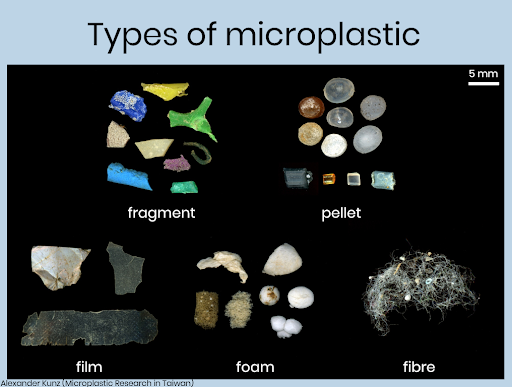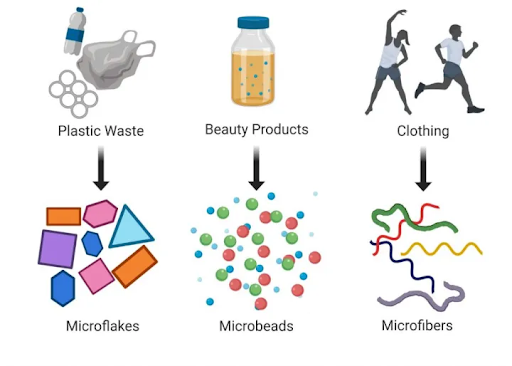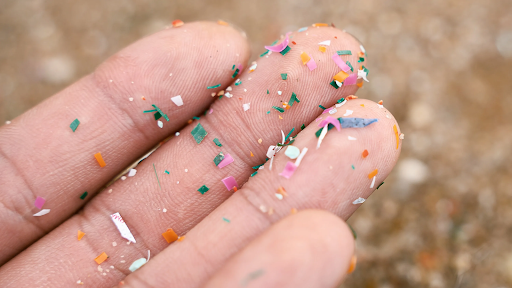Plastic pollution is one of the most pressing environmental issues of our time. It has captured global attention, and for good reason. The detrimental impact of plastic waste on our oceans, ecosystems, and even human health cannot be overstated. While many of us are familiar with the visible plastic items that litter our environment, such as bottles and bags, there is a hidden, insidious form of plastic pollution that is equally concerning – microplastics.
From cosmetics and clothes to car tires and plastic bottles, microplastics are everywhere—and they’re much more diverse than you might think. While many people have heard the term, few realize just how many types of microplastics exist or how each type enters our environment in a different way. This article will help you understand what microplastics are, the categories they fall into, and the surprising sources they come from.
1. What are microplastics?
1.1. Definition and Size Criteria
According to the U.S. National Oceanic and Atmospheric Administration (NOAA) and the European Chemicals Agency, microplastics are tiny plastic particles, typically measuring less than 5 millimeters (mm) in size. These minuscule plastic particles can take various forms, including fragments, fibers, beads, and foam, and they are found in the environment as a result of plastic pollution and the breakdown of larger plastic items, such as plastic bottles, plastic bags, plastic utensils...
In recent years, researchers have also started distinguishing nanoplastics, which are even smaller—typically under 1 micrometer in size. While nanoplastics are an emerging topic, types of microplastics remain the central focus due to their widespread presence in oceans, soil, air, and even our food.
1.2. Why Microplastics Matter
Microplastics are not biodegradable. Once released, they persist in the environment for decades or even centuries. They’ve been found in Arctic snow, the deepest parts of the ocean, and 100% of aquatic species studied in polluted areas.
According to the United Nations Environment Programme (UNEP), over 11 million tons of plastic enter the ocean each year—and a large portion of this breaks down into microplastics over time. These particles can:
- Be consumed by marine animals, birds, and even humans
- Act as carriers for toxic chemicals
- Enter our food chain and drinking water
- Disrupt ecosystems and harm biodiversity
Understanding the different types of microplastics is the first step in addressing their environmental and health impacts.
2. Types of microplastics

Different types of microplastics
2.1. Primary microplastics
Primary microplastics are tiny plastic particles that are intentionally manufactured at a small size for specific purposes. These particles are not the result of larger plastic items breaking down but are designed to be small from the outset. Primary microplastics can be found in various consumer and industrial products and are released into the environment through their use or disposal.
Here are some common examples of primary microplastics:
- Microbeads: Microbeads are tiny plastic beads with a diameter typically less than 1mm. They have spherical plastic particles that are often used in personal care products such as exfoliating scrubs, toothpaste, and cosmetics. They are added to these products to provide texture and abrasion. When these products are washed down the drain, microbeads can end up in waterways and oceans, causing pollution and harm to aquatic life.
- Microfibers: Microfibers are small fibers with a diameter typically less than 1 denier (a unit of measurement for the thinness of fibers) or about 10 micrometers (10 μm). For comparison, human hair is typically about 75 micrometers in diameter. Microfibers have exceptional smoothness and softness, which makes them widely used in many applications, including the production of clothing, household appliances, and cleaning products. In the fashion industry, microfibers are often used to create products such as sweaters, coats, and other high-end fabrics.
- Plastic pellets (nurdles) used as raw materials in plastic manufacturing
- Exfoliating particles in household cleaners or soaps
- Glitter used in craft supplies or makeup
While many countries—including the U.S., UK, and EU nations—have banned microbeads in rinse-off cosmetics, these tiny particles are still used in other industries.
2.2. Secondary microplastics
Secondary microplastics are small plastic particles that result from the breakdown and fragmentation of larger plastic items, as opposed to primary microplastics, which are intentionally manufactured at a small size. Secondary microplastics are created due to various environmental factors:
- Sunlight (UV exposure)
- Mechanical stress (wave action, wind, abrasion)
- Biological degradation (limited)
Here are some common examples of secondary microplastics:
- Fragmented plastics: This category includes small plastic fragments that result from the physical breakdown of larger plastic items like bottles, containers, and packaging materials. These small pieces can be created through a variety of ways, including natural wear due to time and environmental conditions, or through destructive processes such as wave action, sunlight, and exposure to chemicals. These fragments are carried by wind and water and can be ingested by marine and terrestrial animals, causing harm to both wildlife and ecosystems.
- Microplastic pellets (nurdles): This plastic pellet is created from recycling used plastic and processed into small particles ranging in size from 1 to 5 mm. These microplastics are often used as input materials in the production of new plastic products. However, if not managed properly, they can fall into the environment and cause major environmental pollution problems.
- Foamed microplastics: Certain plastic materials used in packaging and insulation are designed to be lightweight and foamy. Over time, these materials can break down into smaller foam particles, becoming secondary microplastics that can contaminate the environment.
3. Sources of microplastics in daily life

Some popular sources of microplastics
Microplastics don’t just come from industrial waste—they’re embedded in our daily lives. Understanding these sources helps identify how individuals and industries contribute to microplastic pollution.
3.1. Household Sources
Many common household activities and products unintentionally release types of microplastics:
- Washing clothes made of synthetic fibers
- Using exfoliating cosmetics with microbeads
- Sweeping or vacuuming plastic-based carpets
- Plastic packaging breaking down over time
- Cleaning sponges, especially those made of polyurethane
These sources often go unnoticed, but collectively, they are significant contributors to microplastic pollution in water and air.
3.2. Industrial and Agricultural Sources
Plastic mulch used in farming gradually degrades under sunlight and mechanical stress.
- Construction materials, including paint, insulation, and sealants, release microplastic dust.
- Factory runoff and improper waste disposal can release large amounts of microplastics into nearby waterways.
- Textile and plastic manufacturing release pellets and synthetic fibers directly into the environment.
3.3. Ocean and Urban Runoff
When it rains, streets and pavements act as conduits that carry plastic particles into storm drains and eventually into rivers and oceans.
Common urban runoff sources include:
- Tire dust from roads
- Paint chips from buildings or signage
- Debris from improperly disposed plastic litter
- Breakdown of plastic in landfill overflow
4. Impact of microplastics

Significantly impact of microplastics in water
The growing presence of types of microplastics is not just an aesthetic issue—it carries serious implications for ecosystems and human well-being.
4.1. Marine Ecosystems
- Fish, plankton, turtles, and seabirds often mistake microplastics for food.
- These particles accumulate in their digestive tracts, leading to malnutrition or death.
- Microplastics also act as carriers for toxins, including PCBs, pesticides, and heavy metals.
The United Nations estimates that up to 51 trillion microplastic particles now float in the oceans.
4.2. Soil and Air Contamination
- Microplastics in soil can alter its texture, reduce fertility, and affect plant growth.
- Airborne microplastics are inhaled daily, especially in urban areas or near synthetic textiles.
- Indoor air contains higher concentrations of microplastics than outdoor air, especially in homes with synthetic carpets and upholstery.
4.3. Potential Human Health Impacts
Though research is still ongoing, some known or suspected effects include:
- Gastrointestinal irritation
- Hormone disruption due to chemicals like BPA and phthalates
- Respiratory issues linked to inhalation of microplastic fibers
- Unknown long-term risks, especially from nanoplastics that may cross into the bloodstream
A 2022 study found microplastics in human blood for the first time, raising alarm among public health researchers.
Read more: Microplastic: the unseen threat to our oceans and planet
5. Can we reduce microplastic pollution?
While eliminating microplastics entirely is nearly impossible, many steps can be taken to reduce their presence and impact.
5.1. Government Regulations
- Several countries have banned microbeads in cosmetics (e.g., US, UK, Canada).
- Extended Producer Responsibility (EPR) laws push companies to take accountability for post-use plastic.
- The European Union’s Green Deal proposes restrictions on microplastic use in synthetic turf, paints, and detergents.
5.2. Consumer Choices
As individuals, you can help by:
- Avoiding products with microbeads
- Using natural fiber clothing instead of polyester
- Installing microfiber filters in washing machines
- Reducing single-use plastics and packaging waste
6. Conclusion
Microplastics are a silent but pervasive form of plastic pollution that poses significant threats to our environment, wildlife, and ultimately, human well-being. Recognizing the various types of microplastics, their sources, and their impact is the first step toward addressing this critical issue. Mitigation efforts must focus on reducing the use of primary microplastics, minimizing plastic waste, and implementing effective waste management and recycling practices. The fight against microplastic pollution requires global collaboration and individual responsibility to protect the planet for future generations.
7. About EuroPlas
EuroPlas, with a team of experienced and professional staff, is committed to providing customers with high-quality products and services. With 18 years of experience in the industry, we have earned a strong presence and reputation for delivering high-quality plastic materials and masterbatch solutions to meet the diverse needs of our clients. At the same time, we always put environmental protection and sustainable development first, therefore, we have continuously produced bioplastic products - Bio filler, ensuring both environmental friendliness and environmental friendliness. while increasing the efficiency of raw material costs. Get to know more at our website and contact us to be supported with the products that you need.